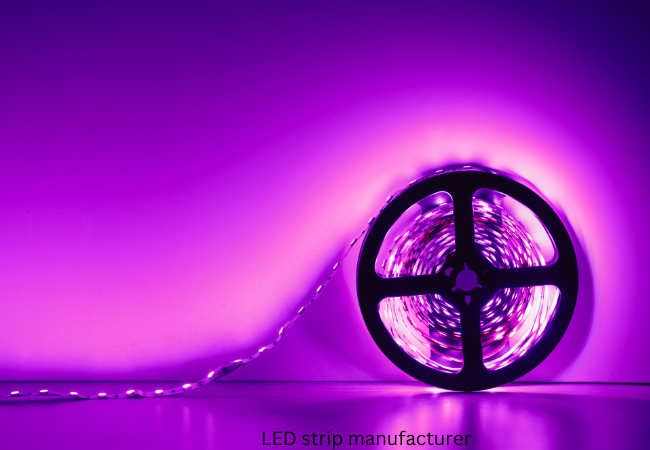LED Strip Manufacturer: Your Guide to Choosing the Best

LED strip lights have become a popular choice for both residential and commercial lighting applications due to their versatility, energy efficiency, and ease of installation. As the demand for LED strips continues to grow, so does the number of manufacturers entering the market. Understanding the intricacies of LED strip manufacturing can help consumers and businesses make informed decisions when selecting products and suppliers.
Overview of LED Strip Technology
LED Strip Manufacturer lights are flexible circuit boards populated with light-emitting diodes (LEDs) that can be adhered to almost any surface. This technology allows for creative and dynamic lighting solutions, making them ideal for a wide range of applications, from under-cabinet kitchen lighting to large-scale architectural installations.
Importance in Modern Lighting
The importance of LED strip lighting in modern lighting design cannot be overstated. They offer significant energy savings compared to traditional incandescent and fluorescent lighting, have a longer lifespan, and are available in a variety of colors and brightness levels. These features make LED strips a cornerstone in the push towards more sustainable and energy-efficient lighting solutions.
Understanding LED Strips
Types of LED Strips
LED strips come in several types, each suited for different applications. These include:
- Single-color strips: Ideal for basic lighting needs where only one color is required.
- RGB strips: Capable of displaying multiple colors and can be controlled to change colors dynamically.
- RGBW strips: Similar to RGB but with an additional white LED for improved brightness and more accurate color mixing.
- Addressable LED strips: Each LED can be individually controlled, allowing for complex lighting effects and animations.
Applications and Uses
LED strips are used in a variety of settings, including:
- Residential: Accent lighting, under-cabinet lighting, stair and hallway lighting.
- Commercial: Retail displays, office lighting, signage.
- Industrial: Warehouse lighting, machinery illumination.
- Entertainment: Stage lighting, set design, mood lighting in venues.
Advantages of LED Lighting
LED lighting offers numerous advantages over traditional lighting technologies, such as:
- Energy Efficiency: LEDs use significantly less power.
- Longevity: LEDs have a lifespan of up to 50,000 hours or more.
- Durability: LED strips are resistant to shock and vibration, making them suitable for various environments.
- Flexibility: They can be cut to size and shaped to fit specific needs.
Key Components of LED Strips
LED Chips
The core component of any LED strip is the LED chip. These tiny semiconductors convert electrical energy into light. The quality, color, and efficiency of an LED strip are largely determined by the type of LED chips used.
Circuit Boards
LED strips use flexible circuit boards, typically made from materials like polyimide or polyester, which support the LEDs and electrical components. The design of the circuit board affects the durability and flexibility of the strip.
Power Supply Units
LED strips require a power supply unit (PSU) that converts AC power from the electrical outlet to the DC power required by the LEDs. The PSU must be compatible with the strip’s voltage and current requirements.
Controllers and Accessories
Controllers are used to manage the operation of LED strips, especially for RGB and addressable types. They allow users to change colors, brightness, and effects. Accessories like connectors, mounting hardware, and diffusers enhance the functionality and installation of LED strips.
The Manufacturing Process
Design and Prototyping
The manufacturing process begins with design and prototyping. Manufacturers create detailed specifications, including the type of LED chips, circuit design, and desired color temperature. Prototypes are developed to test the design’s functionality and performance.
Material Selection
Choosing the right materials is crucial for the quality and durability of the LED strips. This includes selecting high-quality LEDs, reliable circuit board materials, and suitable encapsulation methods to protect the LEDs.
Assembly and Testing
During assembly, LEDs are mounted onto the circuit boards using automated machinery. Once assembled, the strips undergo rigorous testing to ensure they meet the required performance standards, including brightness, color accuracy, and power consumption.
Quality Control in LED Manufacturing
Standards and Certifications
Quality control is essential in LED manufacturing. Reputable manufacturers adhere to industry standards and obtain certifications such as CE, RoHS, and UL. These certifications indicate compliance with safety, environmental, and performance criteria.
Testing Procedures
Testing procedures include electrical tests, thermal cycling, and color consistency checks. These tests ensure that the LED strips perform reliably under various conditions and maintain consistent color output.
Ensuring Consistency and Reliability
Manufacturers use automated processes and strict quality control measures to ensure that every LED strip produced is consistent in quality and performance. This includes batch testing and inspection of components.
Innovations in LED Strip Technology
Smart LED Strips
The advent of smart technology has brought innovations to LED strips, allowing them to be integrated into home automation systems. Smart LED strips can be controlled via smartphone apps, voice assistants, and other devices, offering greater convenience and control.
Energy Efficiency Improvements
Advancements in LED chip technology and power management have led to more energy-efficient LED strips. These improvements reduce power consumption while maintaining high brightness and color quality.
Advances in Color and Brightness
Newer LED strips offer a broader range of colors and improved brightness levels. Enhanced phosphor coatings and multi-chip designs allow for better color rendering and more vibrant displays.
Choosing the Right LED Strip Manufacturer
Factors to Consider
When choosing an LED strip manufacturer, consider factors such as product quality, pricing, lead times, and customer service. A reliable manufacturer will provide detailed product specifications, offer customization options, and have a track record of delivering high-quality products.
Evaluating Manufacturer Capabilities
Evaluate the manufacturer’s capabilities in terms of production capacity, technological expertise, and quality control processes. A good manufacturer will have the necessary certifications and be able to demonstrate their commitment to quality and innovation.
Importance of Customer Support
Customer support is crucial in resolving issues, providing technical assistance, and ensuring a smooth purchasing experience. Choose a manufacturer that offers responsive and knowledgeable support services.
Top LED Strip Manufacturers in the Market
Leading Brands
Some of the leading brands in the LED strip market include Philips, Osram, and Cree. These companies are known for their high-quality products and innovative technologies.
Market Trends
The LED strip market is growing rapidly, driven by increasing demand for energy-efficient lighting solutions and advancements in smart lighting technology. The market is also seeing a rise in customization options and the use of environmentally friendly materials.
Comparing Manufacturers
When comparing manufacturers, consider factors such as product range, pricing, warranty, and customer reviews. Look for manufacturers that have a strong reputation for reliability and quality.
Custom LED Strip Solutions
Customization Options
Many manufacturers offer customization options for LED strips, including different colors, sizes, and shapes. Customization allows businesses and individuals to get lighting solutions that precisely meet their needs.
Working with Manufacturers
Working closely with manufacturers can help in getting the best custom solutions. This includes discussing specific requirements, understanding the technical specifications, and ensuring that the product meets the desired standards.



